French press and percolator are close competitors. They don’t require electricity, making them popular choices if you want a cup of joe while camping. Attention to detail will be required as you decide between percolator vs. French press, as there are several reasons why one coffee maker might meet your needs better than another.
What is a percolator?
A percolator is a coffee pot with a simple two-chamber design. Water goes into the bottom chamber, coffee grounds go to the top, and a vertical tube connects the two chambers. You brew coffee by putting the percolator on a heat source, like a stovetop or a campfire. As the percolator heats, the water in the chamber becomes steam, and the pressure sends it up into the upper chamber.
This part of the process is pretty similar to an Italian Moka brewer. However, what makes a percolator different is that the water circulates back and forth between the two chambers instead of just staying in the upper part. After several minutes of this cycling, the percolator coffee is ready to drink.
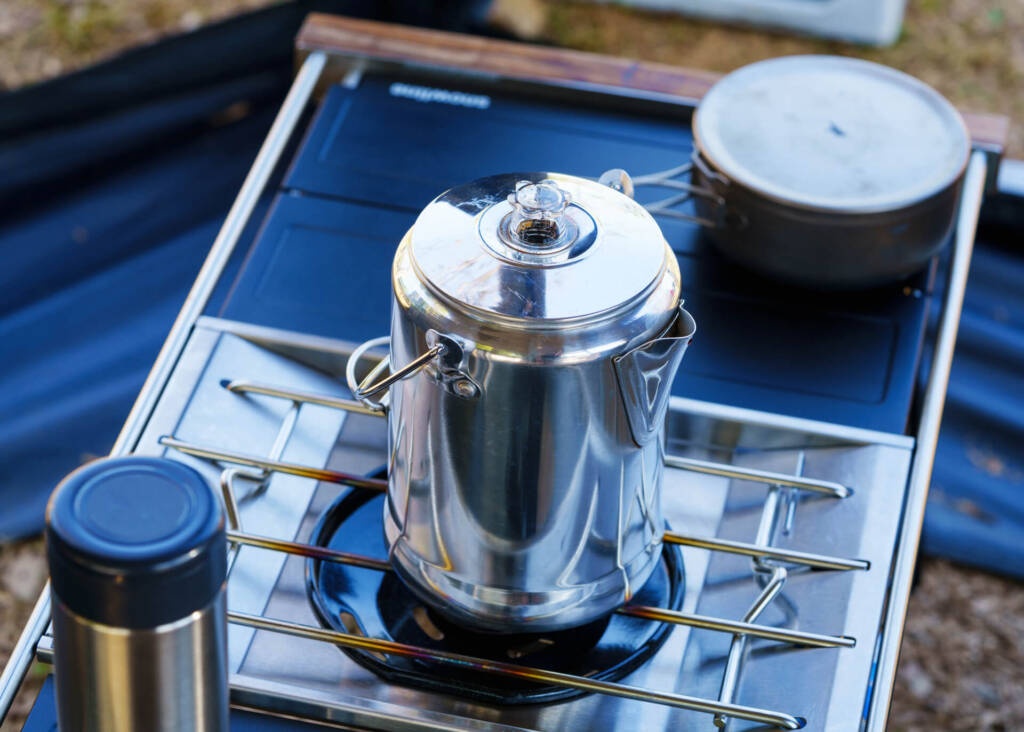
What is a French press?
A French press is a wonderfully low-tech coffee maker loved for its simplicity. Its two main components are a brewing chamber and a plunger.
You put coarse coffee grounds in the brewing chamber and fill it up the rest of the way with hot water. You let it sit for a few minutes, then depress the plunger to separate the grounds from the brew.
You don’t need an electrical outlet nearby to use a French press. You just need the ability to boil water. Whether you use a stove burner or a fire to produce your hot water, you’ll pour it from your kettle into the carafe of your French press.
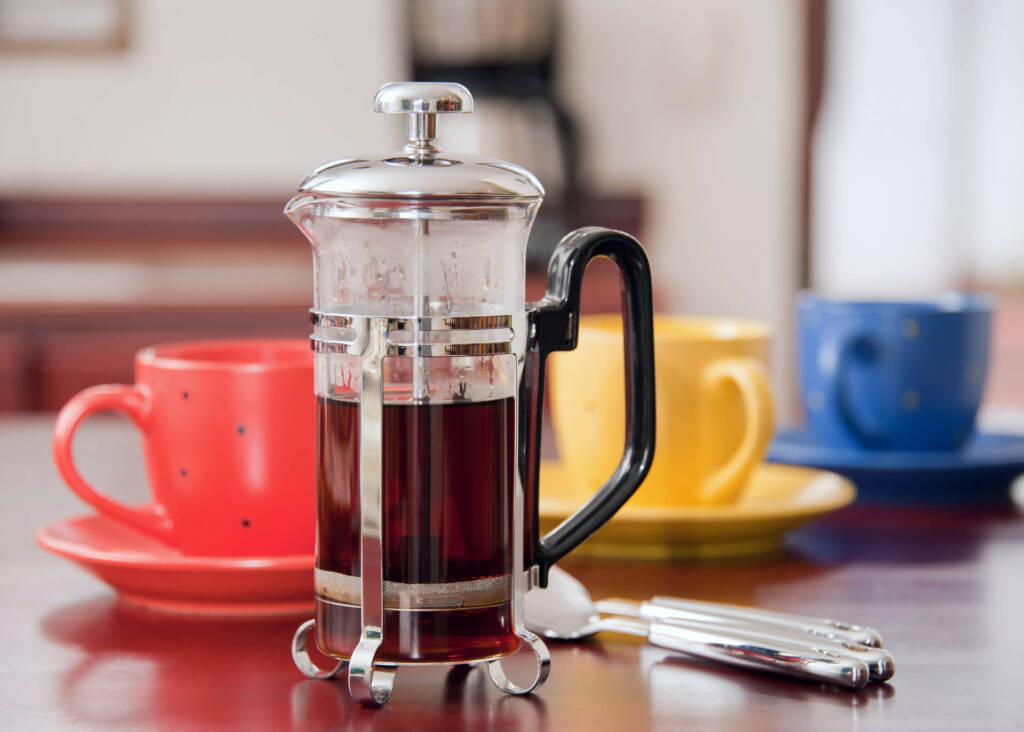
Percolator vs. French Press: which is the best for you?
As you look at the percolator vs. French press question for your next coffee maker, you’ll want to consider many variables in your comparison. A delicious cup of coffee is probably a high priority. However, other factors like brew time, cost, and ease of use could also affect your choice of coffee brewing devices.
Ease of use
Brewing coffee should not be a difficult chore, so ease of use is important in determining whether to get a percolator or a French press coffee maker.
Percolator
Using a coffee percolator is very simple. Pour water into the lower chamber and add coffee grounds to the filter basket. Then, you put it on a stove burner and turn it on. You’ll flip the switch or press a button to turn it on for an electric version of the percolator.
The ideal grind size for a percolator is coarser than you can buy in a supermarket. However, the machine will at least function with packaged pre-ground coffee, so many people use that in a pinch — especially if they have a large percolator to serve a crowd. The drawback is that a fine grind can cause over-extraction and residue in your coffee.
The only potential challenge with using a percolator is that you’ll have to know when it’s done brewing. For a stovetop model, you can usually tell it’s time to take the coffee maker off the burner when it stops making a sputtering sound. You’ll have to pay attention to it instead of getting lost in your favorite TV show.
The advantage of electric percolator models is that they reduce the heat automatically at the appropriate time.
This premium unit produces about one cup per minute, so there’s no waiting around for delicious coffee. The automatic 'keep warm' function gently warms coffee after perking, and the detachable cord makes for easy pouring and storage.
French press
The toughest part of using a French press is that it doesn’t work well with packaged ground coffee’s standard grind. It needs coarsely ground coffee to extract the flavor from the bean properly.
While you can buy pre-ground coffee for French press online, you may want to consider getting a grinder and grinding the beans yourself to achieve the best flavor in your cup. A fresh grind always tastes the best!
However, a French press coffee maker is easy to use once the coffee grinds are ready. Simply add hot water to the grounds in the French press, stir, and let it infuse. You may want to give it another stir partway through the steeping time. Then, depress the plunger to separate the brewed coffee from the grounds, and your delicious coffee is ready to serve!
Like a French press, a Chemex is another low-tech coffee maker where you add near-boiling water. However, a sturdy French press offers portability and durability that the fragile glass Chemex does not — that’s the one you want to take on your next trip!
Winner
A percolator is slightly easier to use than a French press because you can prepare your brew with store-bought coffee. Neither is very complicated to brew coffee with, though.
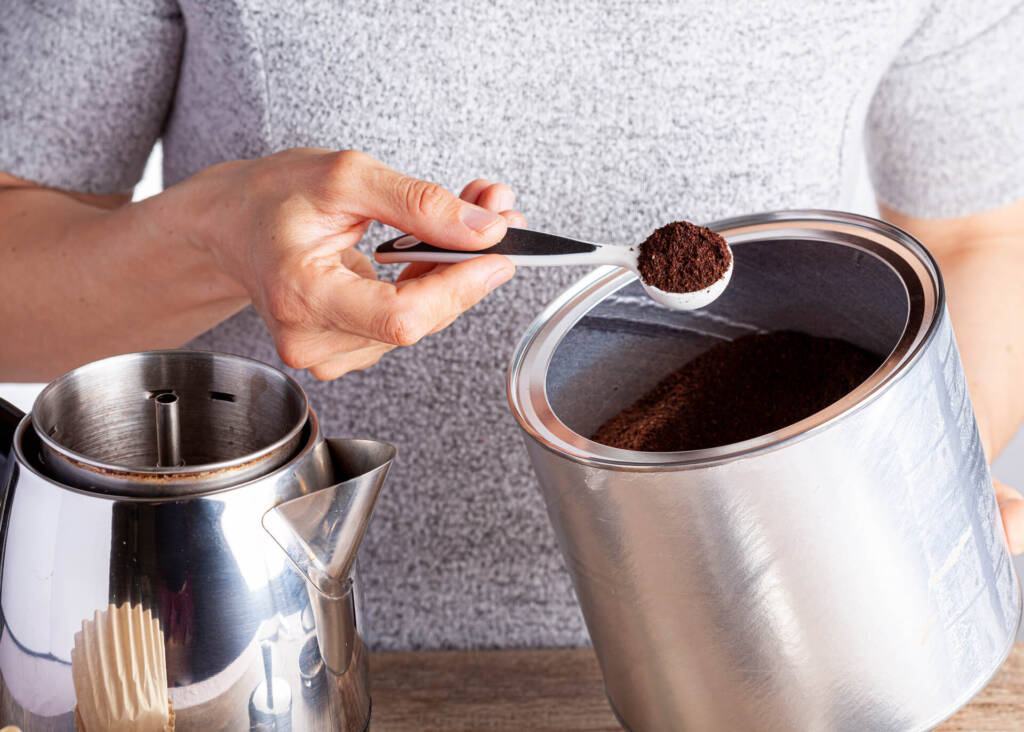
Brewing time
You’ll probably want your morning cup of coffee quickly, so knowing the brewing time is an important part of your decision on the French press vs. percolator dilemma.
Percolator
The typical brew time of a percolator is six to eight minutes. Less time will result in weak and watery coffee. You can let it run a little longer if you prefer strong coffee. It shouldn’t brew longer than ten minutes, though — that will produce over-extracted and bitter coffee with uncomfortably high caffeine content.
If you grind your own coffee, this will add to your brew time. Some people are willing to sacrifice great coffee, while others find it too time-consuming. It’s just a matter of personal preference!
French press
You have to heat the water separately before pouring it into your French press. How long that takes will depend on your heat source. You can at least grind your coffee beans while the water heats.
However, after adding the heated water to the coffee grounds, the French press brew time is only about four minutes.
Winner
A French press brews coffee more quickly, although the other tasks associated with brewing probably make the time spent about even.
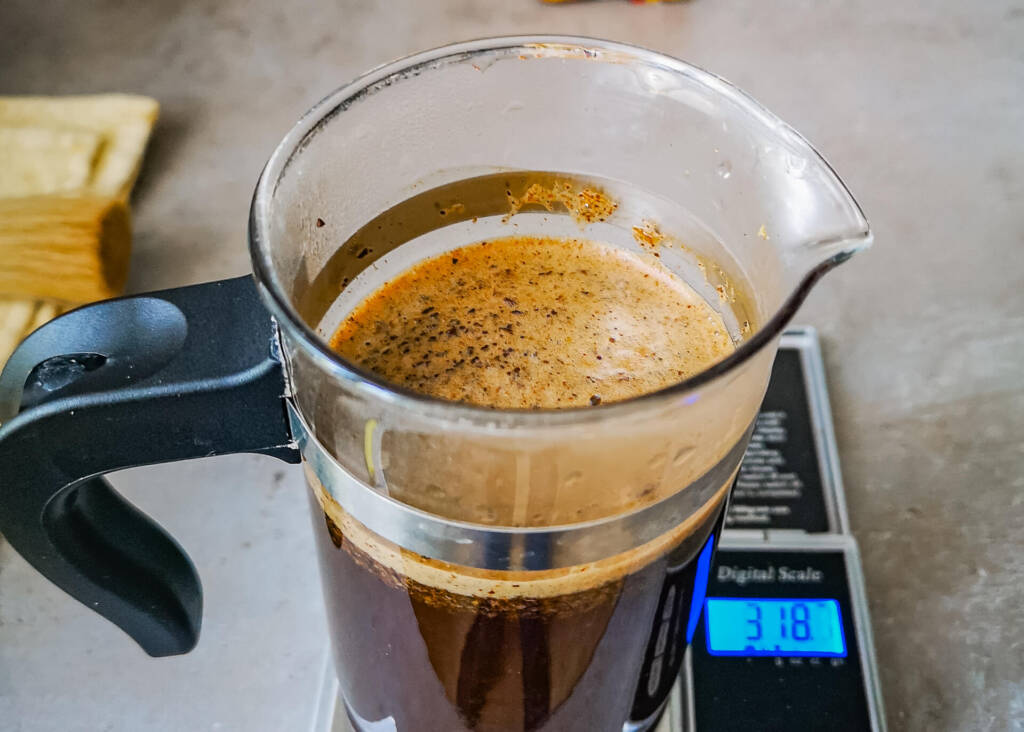
Capacity
Knowing how much coffee you expect to brew is important in choosing the right coffee maker. Both French press and percolator coffee makers come in a variety of sizes. However, their strengths and weaknesses can become more apparent at the extremes of the size spectrum.
Percolator
A large electric percolator is commonly present at churches and other gathering places where it’s necessary to serve a big crowd of coffee drinkers and keep coffee warm for a while. This brewing process is ideal for brewing large batches of coffee quickly. However, small percolators that make two to four cups of coffee at a time are available in the market.
A Moka Pot, often called a stovetop espresso maker, might be a better alternative to a percolator at the small end of the size range. It produces higher-quality coffee, although it is a strong brew. Remember that Moka Pot sizes are based on espresso shot cups of 1 to 2 ounces, while percolators, like drip coffee machines, are sized based on 5-ounce cups of coffee.
Farberware 2-4-Cup Electric Percolator
1000-watt, two- to four-cup percolator quickly brews at cup-a-minute speed. Once the brewing is complete, the percolator automatically switches to the "keep warm" temperature. Stainless steel construction offers durability and the detachable cord makes for easy serving. Rolled edges offer safe handling as do the stay cool handle and cover knob.
French press
The average French press is the 8-cup size, which holds about 34 ounces (1 liter). However, the range of French press sizes is from 3 to 12 cups. The 3-cup size holds about 12 ounces (0.35 liters), and this would be a great portable option for stuffing in a backpack on a camping trip.
One key advantage of a French press, unlike a percolator or stovetop espresso maker, is that you don’t have to fill it all the way to get it to work properly. You can make a single cup of coffee with a larger French press — it’s effectively adjustable! — while a percolator needs the recommended amount of water and coffee to brew.
In a French press, the coffee grinds won’t rise any higher than the water level no matter how much water or coffee you put in, and nothing needs to move from one chamber to another, so nothing can go wrong. You can make a partial batch of full-flavored coffee if you have the right grounds and hot water balance.
Winner
A percolator is best if you intend to brew large amounts of coffee. If you’ll only make small batches, the versatility of a French press is preferable.
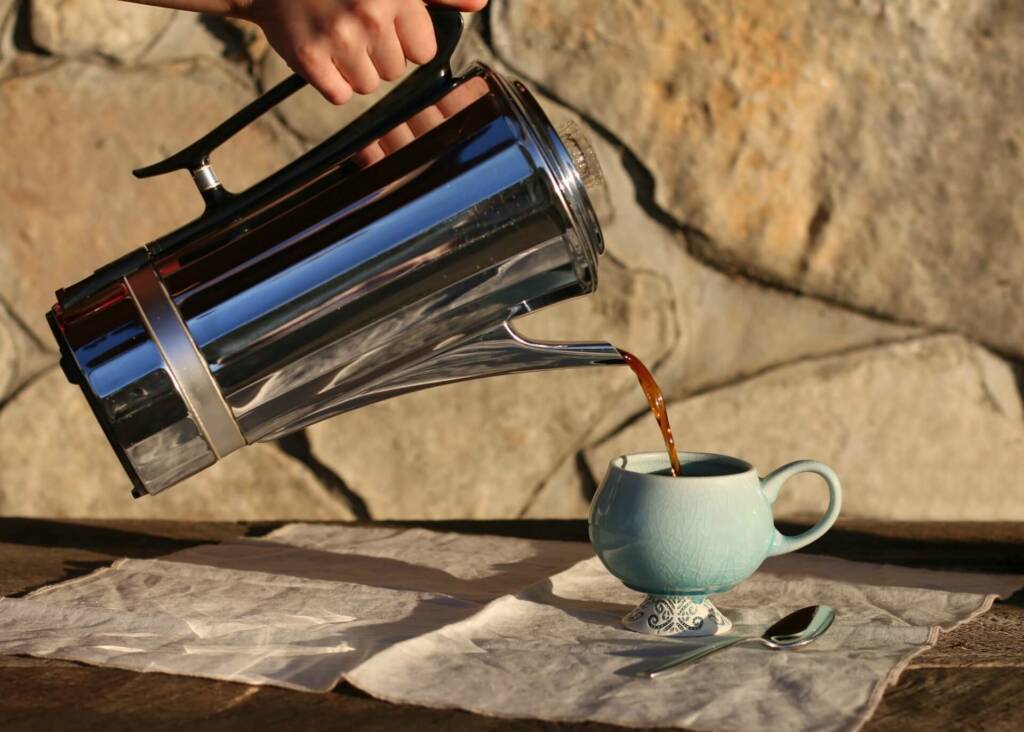
Taste
Any coffee maker’s output is substantially influenced by the quality of the coffee you use for brewing. That said, some brewing methods are better than others at producing the most flavorful coffee possible — and, of course, you probably want coffee that tastes great!
Percolator
Percolators are renowned for quickly producing large amounts of coffee, but this convenience comes at the cost of taste. This brewing method recirculates brewed coffee while heating it, so it can be bitter. You can somewhat mitigate the flavor problems by using a coarse grind size coffee, although grinding large amounts may not be convenient with a coffee maker designed to brew a huge batch.
Electric percolator models may also handle some of these issues better than stovetop models. With a built-in temperature control switch, there’s less risk of the coffee being burned. Still, you are not likely to catch the delicate coffee notes that other brewing methods are equipped to bring out.
If you typically add a lot of cream and sugar to your coffee, you might not notice the lackluster flavor of this brewing method. Consider your taste as you decide on the best coffee maker for you.
Bodum Chambord French Press, 8 Cup
Chambord French press brews a premium cup of coffee in just 4 minutes. Simply add coarse ground Coffee, and hot water, and press. The 3-part stainless steel plunger has a mesh filter that helps extract your coffee's aromatic oils and subtle flavors.
French press
A French press coffee maker requires coarse grounds, so you must grind the beans before brewing. With the temptation to buy basic packaged coffee taken away from you, you might as well get the best beans you can afford! Dark roast coffee works especially well with a coffee press.
Therefore, French press coffee makers are a favorite of coffee lovers who care about subtle flavor differences. There’s no paper filter in a French press to remove oils, so you wind up with a thick, full-bodied brew.
Winner
The French press produces a richer, more flavorful cup of coffee with more depth. If you drink coffee for pleasure, not just caffeine, you want a French press coffee maker.
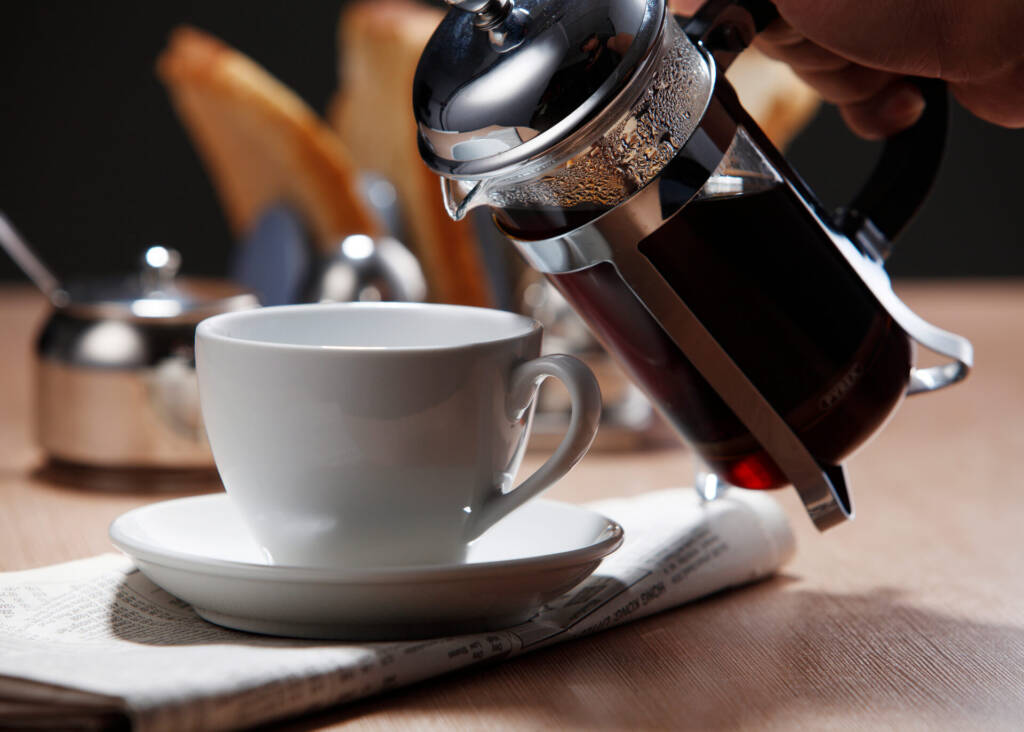
Cleaning
Cleaning and maintaining your coffee brewer is an often-overlooked part of any coffee brewing method. How do these two coffee makers compare?
Percolator
How you’ll clean your percolator depends on what it’s made out of. You can typically put stainless steel percolators into a dishwasher. However, some lower-end models are made of aluminum, which is not dishwasher-safe. Those percolators must be washed by hand in warm water with dish soap.
French press
Most French presses can be cleaned in the top rack of a dishwasher. The glass carafe separates from the stainless steel or plastic.
A quick rinse should be sufficient if your French press is not dishwasher-safe. It may need occasional deeper cleaning using dish soap and warm water.
Winner
Pay attention to what your device is made of — as long as you have stainless steel, either the percolator or the French press coffee maker should be easy to wash.
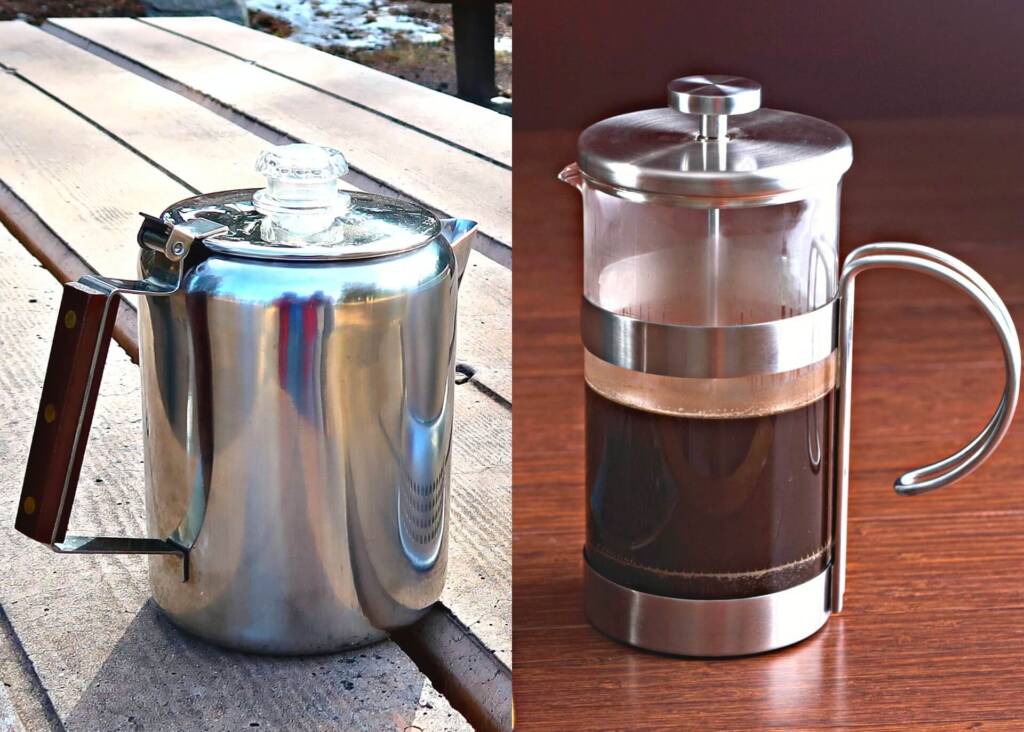
Cost
Of course, your budget will be a big part of determining the best option for you. As a bonus, neither French presses nor percolators have the ongoing expense of paper filters.
Percolator
Stainless steel percolators start at around $40. You can find lower-end aluminum models for a lower cost.
Some percolators have optional paper filters to reduce coffee grit, and this may be worth looking into if you prefer a smooth brew. However, you won’t need additional special equipment. Getting a good coffee grinder is nice but not mandatory.
French press
French presses start around $20. You can pay more for extra features like insulated walls to enjoy hot coffee longer. The basic mechanics of a coffee press are pretty simple, though, so there’s no need to overspend.
French presses require coarse grind coffee, so you might have to invest in a good coffee grinder if you don’t have one already. You’ll also need a kettle or other source of hot water. However, you couldn’t buy paper filters for your French press if you wanted to — the built-in stainless steel mesh filter is all you need!
Bayka French Press Coffee Maker
Made of high-quality borosilicate glass, the Bayka French press is resistant to thermal shock and can withstand high temperatures, making it durable and long-lasting. The glass carafe can be easily taken apart for a thorough cleaning, and certain parts, such as the plunger and filter, are dishwasher safe.
Winner
Both of these coffee makers are generally available for a reasonable price. While you can find better quality or more sophisticated designs and, therefore, more expensive percolators and French presses, a French press is generally cheaper.
Overall, the French press method is preferred by coffee aficionados. You have more control over the brewing process and can adjust many factors to your taste. However, it’s good to know about percolator coffee pots if you are ever charged with making coffee for a large group of friends or want a sturdy coffee pot to take on a camping trip.




